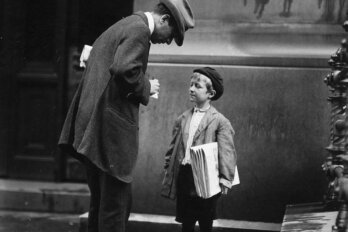On a sunny afternoon in early March 2020, just days before the country—and world—experienced its first COVID-19 lockdown, Julie Dabrusin, then the parliamentary secretary to the minister of Canadian heritage, was in a crowded conference room to introduce a panel entitled “Writing the Next Chapter: Investing in Canada’s Creative Economy.”
We are here, she told the audience of publishing and business people, to celebrate “the importance of telling Canadian stories” and the importance of the economy’s cultural sector, which contributes $53 billion to the country’s GDP, more than agriculture, forestry, and fishing combined. The cultural industries are major drivers of employment, responsible for more than 666,500 jobs in Canada, including jobs for writers and filmmakers and studios and the coffee shops and spinoff industries that serve them.
“We . . . know Canada’s creators are facing many challenges,” said Dabrusin, “[and] deserve to be paid their fair share and be remunerated fairly.” She stressed the importance of Canadians, including young people, having access to a wide variety of Canadian “content”: “I want my own children to read Canadian stories,” she said.
When the panel moderator turned to writer Sylvia McNicoll and asked to what she credited her “longevity as a writer,” McNicoll gave an unexpected—and honest—answer: “I credit my longevity as a writer to always being able to accept less income.”
When talking about an industry that brings $1.7 billion to the Ontario economy alone, her statement is shocking—but so are the numbers. “There’s a class issue that we don’t always talk about in writing and publishing, where you need to be able to afford this life,” acknowledged John Degen, the executive director of the Writers’ Union of Canada. He pointed out that the average annual income authors earn from their writing is around $10,000.
As a result, there will be voices and stories we won’t and can’t hear. “We are not going to hear from poor people,” said McNicoll. They’re too busy hustling multiple jobs, they’re tired, they don’t have the resources to buy the mental space to write. This means that the stories we do hear will be told by certain specific voices: those who can afford to tell stories, whether those stories are their own or others’. In a later conversation with me, McNicoll noted she had been able to operate as a writer making less and less money because she had other jobs and because she had a husband with a full-time job.
McNicoll pointed out that, while you often don’t hear poor people telling their own stories, in their own words, you do still get stories about poor people. But those stories are often told from the point of view of those who haven’t lived the life, who don’t have lived experience being poor. The stories they tell are, she feels, either largely aspirational or cheerfully affirming, and only rarely do they grapple with what it means to be poor, with details about the struggles and the joys, the daily grind of life.
“I guess sometimes when you’re writing for the mainstream . . . people may not be ready for the edge of the truth,” she says.
When we talk about class in terms of voice, what we are talking about is whose stories are heard—by the mainstream, by policy makers, by those in power—and, by extension, whose voices will shape the wider cultural narrative and decide what it’s going to be.
When it comes to publishing, some attempt has been made to understand who, exactly, decides which stories are going to be published. A recent survey conducted by the Canadian book industry’s trade magazine Quill & Quire showed that almost 77.7 percent of people employed in the Canadian industry are age forty or under and 84.1 percent are women. Only 12.8 percent of respondents identified as non-white. Compare these with figures from the 2021 Canadian census which show that 50 percent of the population identify as women, 48 percent are under the age of forty, and 27 percent identify as a visible minority—clearly there’s an imbalance in representation in publishing.
When we speak of those responsible for approving stories in the film and television industries and on digital platforms such as Netflix, we’re largely talking about the producers and financiers. In 2020, the film industry contributed, according to the Canadian Media Producers Association, $12.2 billion to the national economy while creating approximately 244,500 jobs. The association’s aspirations are lofty: “What unites a population of 36 million citizens, spread across 10 million square kilometres?” it asks on its website. “In large part, it is the stories we tell to one another and the world. Storytelling doesn’t just advance our culture; it is our culture.” Producers develop those stories, then pitch them to line up funding and distribution and broadcast opportunities—meaning, once they decide which stories they think will fly, they must approach other levels of gatekeepers who will play a large role in deciding whether these stories will be funded and aired.
All of this is part of what Dabrusin calls the creative industries. If these publishers and producers and distributors and broadcasters are the gatekeepers of culture, as a group, they are still fairly homogenous. Yet they play an outsize role in determining whose stories we see and hear. And what they need to do better is ensure that there is more variety—in terms of race, class, gender, or some intersection of those.
Convincing cultural gatekeepers of the value—and the business case—of stories that portray a world beyond the familiar or comfortable is a continual challenge. When actor and filmmaker Jo Vannicola is making a film, much like their current project about LGBTQ youth who were forced to leave home and ended up living on the streets, they’re also trying to find ways of getting it funded and distributed. Their income is often, as a result, quite precarious—a choice they make in order to tell the stories they feel deserve attention.
Many of the youth featured in Vannicola’s stories escaped from small towns, from homes of various classes where their sexuality or their gender identity wasn’t accepted. It’s not the type of story the young people themselves are able to tell: they are too focused, Vannicola points out, on simply trying to make it through the day, to maintain a little dignity—finding public washrooms, for example, so they can keep clean. Vannicola is aware that this places them, as a filmmaker, in a position of both privilege and power and that they must be very careful with how they proceed.
At the beginning of every new project, Vannicola heeds a few reminders they’ll need to keep in mind. “I’m going to have some hurdles here. I’m going to rub up against . . . judgments and thoughts: Who’s going to want to watch this movie? Who’s going to want to fund this film?”
Those challenges, the self-doubt that gnaws at their confidence, won’t stop Vannicola from telling their subjects’ stories. “Because I think it matters.”
Karen Harris and I share a birthday. We discover this as we sit down to an early dinner at Red Lobster.
Her parents divorced just as she finished high school. They sold the house they had in the country outside Peterborough, her mother came to Toronto to look for work, her father remarried, and his new wife didn’t want her living with them. “She told me I could go to a shelter,” Harris recalls. She tried staying at a friend’s house in Peterborough, “but his dad was a raging alcoholic,” and “that didn’t work out.” By this time, her mother had begun to establish herself in the city—she’d acquired an apartment and a job at a medical lab—so Harris followed. She was seventeen, just out of high school, and her mother helped get her a job at the medical lab, a job she stayed in for the next decade.
During this time, Harris had her first violent relationship, a boyfriend she was with for four years. Drinking had been part of the culture when she was a teenager—when the local kids would come out to their property in the country, her dad would buy them a case of beer. But during her twenties, her drinking escalated, and she got into a cycle of toxic, abusive relationships—the kind the neighbours phoned the police about, the kind with yelling and physical abuse. She doesn’t paint herself as a victim; “I hit him too,” she says. Still, she kept up work, switching jobs to become an office supplies buyer, trying sporadically to “get sober.”
At thirty-six, she finally managed to quit the drink—and this time, it stuck. “I’ve been sober for twenty-one years,” she says. Her next job, which she once again kept for “about ten or twelve years,” was working in a distribution centre. Even during all of the really tough times, she has always worked while also acting as caregiver to her mother when she was sick and, then, to her aging aunt and uncle who lived in Peterborough.
Harris is very tiny. She is about five feet one and weighs about ninety pounds. The joints on her fingers and her elbows and knees are swollen; her limbs are bone thin. By 2016, she was experiencing health problems and was diagnosed with nontuberculous mycobacteria lung disease, for which, she says, she was given a course of triple antibiotics. Around the same time, her rheumatoid arthritis flared up. For the next three years, she went through treatments for both—from steroids to prednisone and antibiotics—leaving her without an appetite.
She left her job and applied for employment insurance so she could focus on her health and, since then, has been working seasonal jobs or collecting EI as she deals with her fluctuating health issues. The most recent stretch of EI payments ended in January 2022. Her savings add up to the $11,000 she has left in a registered retirement savings plan, around $1,500 in a tax-free savings account, and a $2,500 overdraft. With no family to fall back on and no inheritance coming, she’s on her own.
“I’ve always been the Energizer bunny, but I just can’t do as much anymore,” she says. While she’d had flare-ups before, she says, “I’m older. It doesn’t seem to be going away. And it’s painful.” She’s still on multiple medications a day and wondering how she’s going to be able to afford them. Her doctor has suggested she apply for a provincial benefit, which covers the cost of prescription drugs and is means tested: how much you receive is determined by your income. In the meantime, she’s trying to find whatever work her deteriorating health allows. She recently found a part-time job that paid $20 an hour: assembling bath and beauty products, standing in one spot all day—something difficult for her to do with her rheumatoid arthritis.
As a single person with no family, she has to rely on herself. “I’m a lone wolf, it’s just me.” She figures if she could get something part time—twenty-five hours a week at $20 an hour, or about $2,000 a month before taxes—she could squeak by. But “it would be really squeaky,” she says.
Another option is the Ontario Disability Support Program, which pays $1,228 a month. If she doesn’t qualify, her only other fallback is Ontario Works (colloquially known as welfare). That financial assistance program pays single people $733 a month. While Ontario Disability recipients are allowed to make up to $1,000 a month without incurring reduced payments, with Ontario Works, you’re only allowed to earn up to $200 a month.
“I mentioned to the worker that wouldn’t even cover my rent,” she says about the Ontario Works payment. “She told me I could go and stay in a hostel or in a rooming house.”
Harris’s options are limited. Applying for those benefits is a time-consuming and uncertain process. What if that doesn’t happen? What will she do if the money runs out and she can’t pay her rent? “I’m staying positive,” she says. “Something will come up.”
The alternative doesn’t bear thinking about; the loss of her home, her dignity, would be catastrophic. But it drives home the point of how precarious life can be. I didn’t have an addiction or mental health issues to deal with, although at one time, I experienced a period of clinical depression. I was lucky enough to have family support, a doctor who cared, and it didn’t turn out to be chronic. I also managed to get an education. Although we shared a birthday, Karen and I, we didn’t exactly share the same experience. But we did share something else: our stories.
That’s one of the most powerful aspects of storytelling: when you hear the first-hand, authentic voices of those who have experiences vastly different from your own, you become a part of the storyteller’s world. “I don’t understand why people feel so threatened by having to learn about a variety of different life experiences—and maybe care about them,” says Vannicola. “Most people are passive, which is part of the problem.” It’s easy to stay within your own community, not having to see how others live, not having to know hardships. And if you don’t know those stories, you don’t have to feel responsible for them.
But who we hear from is often a function of those who have the power to amplify their stories and voices—or, equally, to choose not to hear them. That’s why authentic voices are so important. Listening to a story like Harris’s frames a perspective that allows you to see a different point of view while making it difficult to turn your head away. Then, Vannicola says, you have to ask yourself: What are you going to do about it?
Excerpted from On Class by Deborah Dundas with permission from Biblioasis. Copyright © Deborah Dundas, 2023. No part of this excerpt may be reproduced or reprinted without permission in writing from the publisher.





